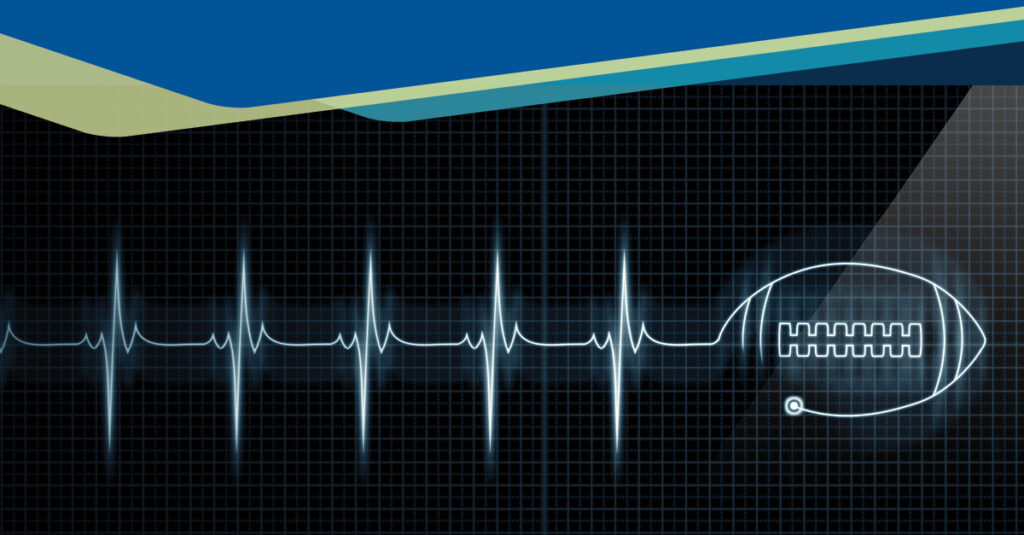Damar Hamlin injury stresses the importance of airway physicians on the field


February 16, 2023
When someone yells, “the red hats are coming,” at a sporting event, they don’t mean we are in the midst of a British invasion, but that the on-field emergency team member wearing a red hat is prepped and ready to attend to an injured player.
Such was the case on January 3, 2023, when Buffalo Bills’ player Damar Hamlin collapsed on the field following a direct hit to his chest. Most likely caused by a rare condition called commotio cordis (Latin for agitation of the heart), Hamlin entered into a state of cardiac arrhythmia (ventricular fibrillation) or arrest. Commotio cordis is sometimes referred to as cardiac death and is believed to happen when there is a physical hit to the chest at a precise moment – when the heart is cycling through a repolarizing electrical current – which causes the heart’s electrical rhythm to be disrupted.
This condition is thankfully infrequent; however, most of these injuries occur to young males (average age of 15 years old) involved in a sport with the potential of receiving a direct blow to their chest of at least 40 mph (e.g., from a baseball, hockey puck, or impact from a football tackle). The hit must be at a 90-degree angle on the left side of the chest (directly over the heart) in the tiny gap of time between the beats of the heart.
A response in a moment’s notice
In Hamlin’s case, the on-field emergency physicians donning signature red hats were there in a second while Hamlin found himself in the greatest fight of his life. As millions of people watched the situation with Hamlin unfold on live television, it prompted many questions about the safety and well-being of athletes.
As football involves significant collisions between players, the National Football League (NFL) understands that professional sports are risky and can result in serious injuries for players. They have prepared years before to address these (and other) potential injuries to enable responsive, interventional care in mere seconds that save precious moments.
The NFL Physicians Society (NFLPS), founded in 1966, requires that approximately 27 to 30 medical personnel be present for each game, along with a medical transport cart and an ambulance. This initiative often incorporates clinicians from both sports teams and the venue. In addition, the medical team includes one airway management physician (and anesthesiologist or an emergency physician), two EMTs/paramedics, four orthopedists, three neurotrauma consultants, one ophthalmologist, a dentist, and a chiropractor.
Furthermore, NFL teams must have an emergency action plan (EAP) approved by the NFL. The home team sends the EAP to the visiting team a week before each game. Then the medical groups meet and share introductions – in person – at least one hour before game time. This is so that everyone understands who is serving in what role. They know where the ambulances are located and the fastest route to a hospital emergency department. The medical teams remain connected via radio throughout the game and use spotters positioned around the venue to capture around 30 different views to spot signs of potential player injury.
Play by play, step by step
If you go back and watch the replay tape of the Bills/Bengals, you will see that Hamlin’s injury immediately triggered the activation of the NFL’s EAP. Within 10 seconds of the collapse, medical personnel were at his side to assess his condition.
Due to the loud ambient noise environment in which they work, the medical team uses hand signals in real-time if there is a major event, rather than trying to shout commands. While the players shielded views of the medical staff working on the field; the team issued a hand signal for a medical cart once it became apparent that Hamlin was unresponsive. When he was observed to be in a state of arrest, the medical team issued an additional hand signal calling for a response from all medical personnel.
There are many potential serious injuries in a game like football, but there is nothing more severe than a player suffering a cardiac arrest. That is why in such cases a specific member of the medical team called the emergency airway physician – who wears a bright red hat and stands on the sideline between the 30-yard line and the endzone – immediately takes charge of securing the player’s airway and directing any resuscitation efforts.
Improving the outcome
All of these actions happened very quickly – and they had to. When Hamlin’s heart stopped pumping and he collapsed on the field, each moment mattered. It is believed that while in this state of cardiac arrhythmia, Hamlin stopped breathing, and his blood was not circulating. He had mere moments before organ death initiated due to oxygen starvation. Time became his enemy.
A person experiencing this condition would not have time to ride to a hospital to get care. They would not have time to wait for advanced medical personnel to travel to the stadium. He would have, at most, a very few moments left before irreversible and permanent damage or death would have begun. Fortunately, the planning, personnel, equipment, training, and communication all led to the possibility of a positive outcome. In fact, in a matter of a few days, we all saw Hamlin leave the hospital and fully interact with his family, teammates, and loved ones. Twenty days after the on-field cardiac arrest, he attended the rematch of the two teams in the playoff game.
This very public situation is a good reminder that anesthesia physicians and other dedicated medical professionals provide life-saving care, whether they wear red hats or lab coats, both on the field and off.
By Preston Smith, FACHE